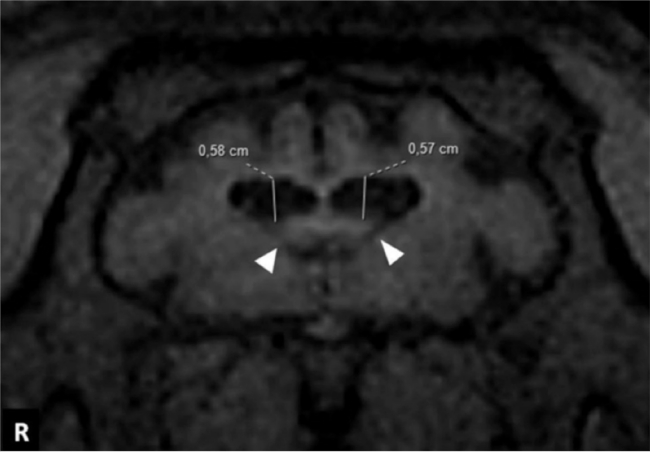Introduction
Hydrochoerus hydrochaeris is the largest rodent with wide distribution in South America. As well as other mammals, the capybara brain has one lateral ventricle within each cerebral hemisphere, which communicates with the third ventricle. In the MRI, the cerebrospinal fluid is hyperintense on T2 sequence and hypointense on T1 sequence, and it is produced by choroid plexus through secretion and ultrafiltration.
Objectives
The aim of this partial study is to describe the lateral ventricles in living capybara by means of MRI providing more detailed information of intracranial structures of this species, for research centers and clinics of wild animal veterinary medicine.
Methods
Eight adult capybaras were submitted to MRI examination using a 0.25 Tesla equipment (Vet-Grande; Esaote, Italy), under general anesthesia using face mask. Anatomical aspects were evaluated by T1W, T2W and FLAIR sequences on the transverse, sagittal and dorsal planes. Lateral ventricle height was measured by T1W-transverse plane at the level of the interventricular foramen.
Results
Lateral ventricles showed as very elongated, with rostral horns extending to the olfactory bulbs and caudal horns to the occipital lobes. The lateral ventricle height (Figure 1) ranged from 0.48–0.67 cm for right side and from 0.48–0.66 cm for left side, with mean of 0.57 cm (SD=0.06) and 0.59 cm (SD=0.06), respectively.
| Figure 1 | 
T1-weighted, 1.4-mm thick, transverse MRI at the level of the interventricular foramina (arrowheads). It is showing the height measurements of the lateral ventricles (RV: 0.58 cm and LV: 0.57 cm). |
|
| |
Conclusions
Capybaras have lateral ventricles longer and wider when compared to domestic animals and rostral horns extended to the olfactory bulb similarly to the horse.